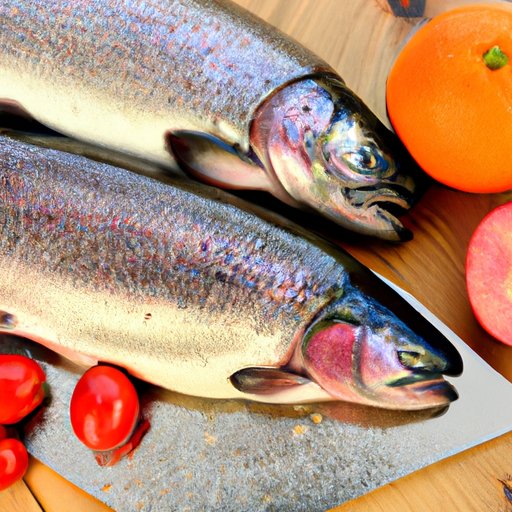Introduction
Trout is a popular type of fish that can be found in freshwater bodies all around the world. It is known for its mild flavor and flaky texture, and is often enjoyed as a healthy source of protein. But is trout really healthy? In this article, we will explore the potential benefits and risks of eating trout to help you decide if it’s a good choice for your diet.

Analyzing the Nutritional Benefits of Trout
Trout is an excellent source of lean protein. A 3-ounce serving of cooked rainbow trout contains 19 grams of protein, which is about 38% of the daily recommended value. Protein is essential for many bodily functions including muscle growth, tissue repair, and hormone production. Trout is also relatively low in calories and fat. A 3-ounce serving contains just 140 calories and 4.5 grams of fat.
In addition to protein, trout is also a good source of micronutrients like vitamins and minerals. It is particularly high in vitamins B6 and B12, as well as niacin, thiamin, riboflavin, folate, and pantothenic acid. Trout is also a great source of minerals like zinc, phosphorus, magnesium, potassium, and selenium. These vitamins and minerals are important for maintaining optimal energy levels, immune system function, and brain health.

Exploring the Health Benefits of Eating Trout
Eating trout on a regular basis may offer several health benefits. For example, one study found that people who ate two servings of trout per week had lower levels of “bad” LDL cholesterol and higher levels of “good” HDL cholesterol than those who did not eat trout. This suggests that eating trout may help reduce the risk of cardiovascular disease.
Trout also contains several nutrients that may help protect against age-related mental decline. The omega-3 fatty acids in trout have been linked to improved cognitive performance and memory. Additionally, the high concentration of B vitamins in trout may help reduce inflammation in the brain and improve overall brain health.
Finally, trout may be beneficial for weight management. The combination of protein, healthy fats, and low calorie content makes it a filling and satisfying food that can help keep you feeling full for longer. This can help prevent overeating and make weight loss easier.
Examining the Omega-3 Content in Trout
Trout is a great source of omega-3 fatty acids, which are essential fatty acids that the body cannot produce. Omega-3s are important for reducing inflammation, regulating heart rate and blood pressure, and improving brain health. One study found that eating trout increased omega-3 levels in the blood by up to 33%.
Omega-3s are found in other fish like salmon, tuna, and mackerel. However, trout contains more omega-3s than these other fish, making it an especially good source of these essential fatty acids. Additionally, trout is typically lower in contaminants like mercury than other types of fish, making it a safer option.
Comparing the Health Benefits of Trout to Other Fish
When comparing the health benefits of trout to other fish, there are a few key points to consider. Nutritionally, trout is a great source of protein and micronutrients like vitamins and minerals. It also contains more omega-3s than most other fish, making it an ideal source of these essential fatty acids. In terms of health benefits, trout may help reduce the risk of cardiovascular disease and help protect against age-related mental decline.
When compared to other fish, trout may have some advantages. For example, trout is typically lower in contaminants like mercury than other types of fish, making it a safer option. Additionally, trout is typically less expensive than other types of fish, making it more accessible and affordable.

Investigating the Potential Risks of Consuming Trout
Although trout has numerous health benefits, there are some potential risks associated with eating it. For example, trout can contain high levels of contaminants like mercury, polychlorinated biphenyls (PCBs), and dioxins. These toxins can accumulate in the body over time and may cause serious health problems.
Additionally, some people may be allergic to trout. Common symptoms of a trout allergy include hives, itching, swelling, and difficulty breathing. If you experience any of these symptoms after eating trout, it’s best to seek medical attention.
Discussing the Role of Trout in a Healthy Diet
Trout can be a healthy part of a balanced diet. The American Heart Association recommends that adults eat at least two servings of fish per week, and trout is an excellent choice. When selecting trout, opt for wild-caught varieties whenever possible, as they tend to be lower in contaminants than farmed varieties.
If you’re concerned about contaminants in trout, you can limit your intake to no more than two servings per week. You can also vary your seafood choices to ensure you’re getting a variety of nutrients. Other types of fish like salmon, sardines, and tuna are also good sources of omega-3s and other essential nutrients.
Determining if Trout is an Ideal Protein Source for Your Health
Overall, trout is an excellent source of lean protein and essential vitamins and minerals. It is also a great source of omega-3 fatty acids, which can help reduce inflammation and improve brain health. Additionally, trout is typically lower in contaminants than other types of fish, making it a safer option.
However, some people may be allergic to trout, and it can contain high levels of contaminants. If you’re concerned about these potential risks, you may want to limit your intake to no more than two servings per week. Additionally, vary your seafood choices to ensure you’re getting a variety of nutrients.
Conclusion
Trout is a popular type of fish that can provide numerous health benefits. It is an excellent source of lean protein, vitamins and minerals, and omega-3 fatty acids. Eating trout may help reduce the risk of cardiovascular disease and improve brain health. Additionally, it is typically lower in contaminants than other types of fish, making it a safer option.
However, some people may be allergic to trout, and it can contain high levels of contaminants. If you’re concerned about these potential risks, you may want to limit your intake to no more than two servings per week. Additionally, vary your seafood choices to ensure you’re getting a variety of nutrients.
Overall, trout can be a healthy part of a balanced diet. As long as you take precautions to minimize potential risks, it can be an ideal protein source for your health.
(Note: Is this article not meeting your expectations? Do you have knowledge or insights to share? Unlock new opportunities and expand your reach by joining our authors team. Click Registration to join us and share your expertise with our readers.)
